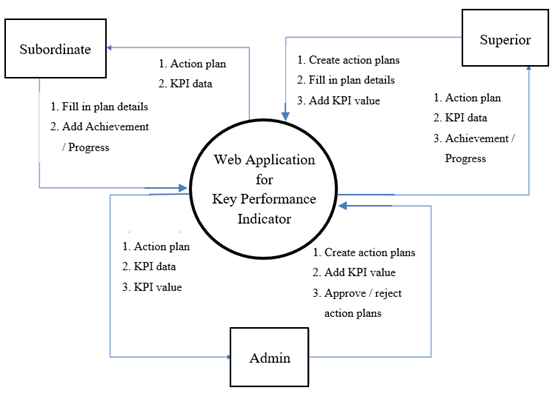Web Application Development for Key Performance Indicator
DOI:
https://doi.org/10.53848/ssstj.v12i2.1010Keywords:
Web application, Key performance indicator, Work performanceAbstract
This research aimed to design and develop a web application for managing Key Performance Indicators (KPIs), focusing on three key areas: project assignment, project progress reporting, and performance evaluation within organizational settings. The study addresses the problem of inefficient, paper-based performance management systems that lack real-time accessibility, role-based task delegation, and strategic alignment. The proposed system incorporates actual KPIs such as task completion rates, timeliness, and goal alignment indicators based on the Balanced Scorecard (BSC) methodology. The development follows the Design Science Research (DSR) framework, ensuring a systematic approach from problem identification to evaluation. Quantitative methods were employed to assess both technical performance and user satisfaction, using structured questionnaires. Evaluation results from five domain experts showed that system performance was rated at the highest level (mean = 4.53, S.D. = 0.47), while feedback from 18 end-users indicated a high level of satisfaction (mean = 4.17, S.D. = 0.72). The novelty of this system lies in its structured role-based interaction (admin, superior, subordinate), integration of performance monitoring with BSC objectives, and a user-friendly, web-based interface that supports real-time monitoring and evaluation.
References
Areerath, W. (2014). Innovation of electronic media grouping for education [Doctoral dissertation, Faculty of Science and Technology]. Phranakhon Rajabhat University, Thailand.
Atikno, W., Setiawan, I., & Taufik, D. A. (2021). Key performance indicators implementation: Literature review and development for performance measurement. Indonesian Journal of Industrial Engineering & Management, 2(3), 189–197.
Blazic, M., Ivetic, D., Popov, S., Berkovic, I., & Ognjenovic, V. (2023). An overview of KPI and metrics in Cloud services. Engineering Conference. Becici, Crna Gora.
Braglia, M., Gabbrielli, R., Marrazzini, L., & Padellini, L. (2022). Key performance indicators and Industry 4.0 – A structured approach for monitoring the implementation of digital technologies. Procedia Computer Science, 200, 1626–1635. https://doi.org/10.1016/j.procs.2022.01.363
Chumpoo, A. (2008). The development of computer programming for calculating key performance indicator (KPI) in jewelry gauge and tester industry. The Journal of King Mongkut's University of Technology North Bangkok, 18(1), 57–67.
Domínguez, E., Pérez, B., Rubio, A. L., & Zapata, M. A. (2019). A taxonomy for key performance indicators management. Computer Standards & Interfaces, 64, 24–40. https://doi.org/10.1016/j.csi.2018.12.001
Gunasekaran, A., & Kobu, B. (2007). Performance measures and metrics in logistics and supply chain management: A review of recent literature (1995–2004) for research and applications. International Journal of Production Research, 45(12), 2819–2840. https://doi.org/10.1080/00207540600806513
Jetter, J., Eimecke, J., & Rese, A. (2018). Augmented reality tools for industrial applications: What are potential key performance indicators and who benefits?. Computers in Human Behavior, 87, 18–33.https://doi.org/10.1016/j.chb.2018.04.054
Morella, P., Lambán, M. P., Royo, J., Sánchez, J. C., & Latapia, J. (2020). Development of a new KPI for the economic quantification of six big losses and its implementation in a Cyber Physical System. Applied Sciences, 10, 9154. https://doi.org/10.3390/app10249154
Parmenter, D. (2020). Key performance indicators: Developing, implementing, and using winning KPIs. Wiley.
Radovanović, D., Holst, C., Belur, S. B., Srivastava, R., Houngbonon, G. V., Quentrec, E. L., Miliza, J., Winkler, A. S., & Noll, J. (2020). Digital literacy key performance indicators for sustainable development. Social Inclusion, 8(2), 151–167.
Sriwapee, K. (2011). Development of information system for evaluation of boyscout activities for students at Mahasarakham Technical College [Master’ thesis, Department of Computer and Information Technology]. King Mongkut’s University of Technology Thonburi.
Tivawong, N. (2012). A web-based information system for performance evaluation case study: Royal Thai Armed Forces Headquarter [Master’s thesis, Faculty of Engineering]. Dhurakij Pundit University.
Tubmongkhon, S. (2021). Information system development for measuring performance with key indicators for Nakhonchai Tour Company Limited. APHEIT Journals, 10(2), 1–9.
Van de Ven, M., Machado, P. L., Athanasopoulou, A., Aysolmaz, B., & Turetken, O. (2023). Key performance indicators for business models: A systematic review and catalog. Information Systems and e-Business Management, 21, 753–794.
Verevka, T. (2018). Key performance indicators of high-tech enterprises. SHS Web of Conferences, 44, 00077.

Downloads
Published
How to Cite
Issue
Section
License
Copyright (c) 2025 Suan Sunandha Rajabhat University

This work is licensed under a Creative Commons Attribution 4.0 International License.











